child lock MAZDA MODEL 3 HATCHBACK 2010 Owner's Manual (in English)
[x] Cancel search | Manufacturer: MAZDA, Model Year: 2010, Model line: MODEL 3 HATCHBACK, Model: MAZDA MODEL 3 HATCHBACK 2010Pages: 488, PDF Size: 6.52 MB
Page 9 of 488
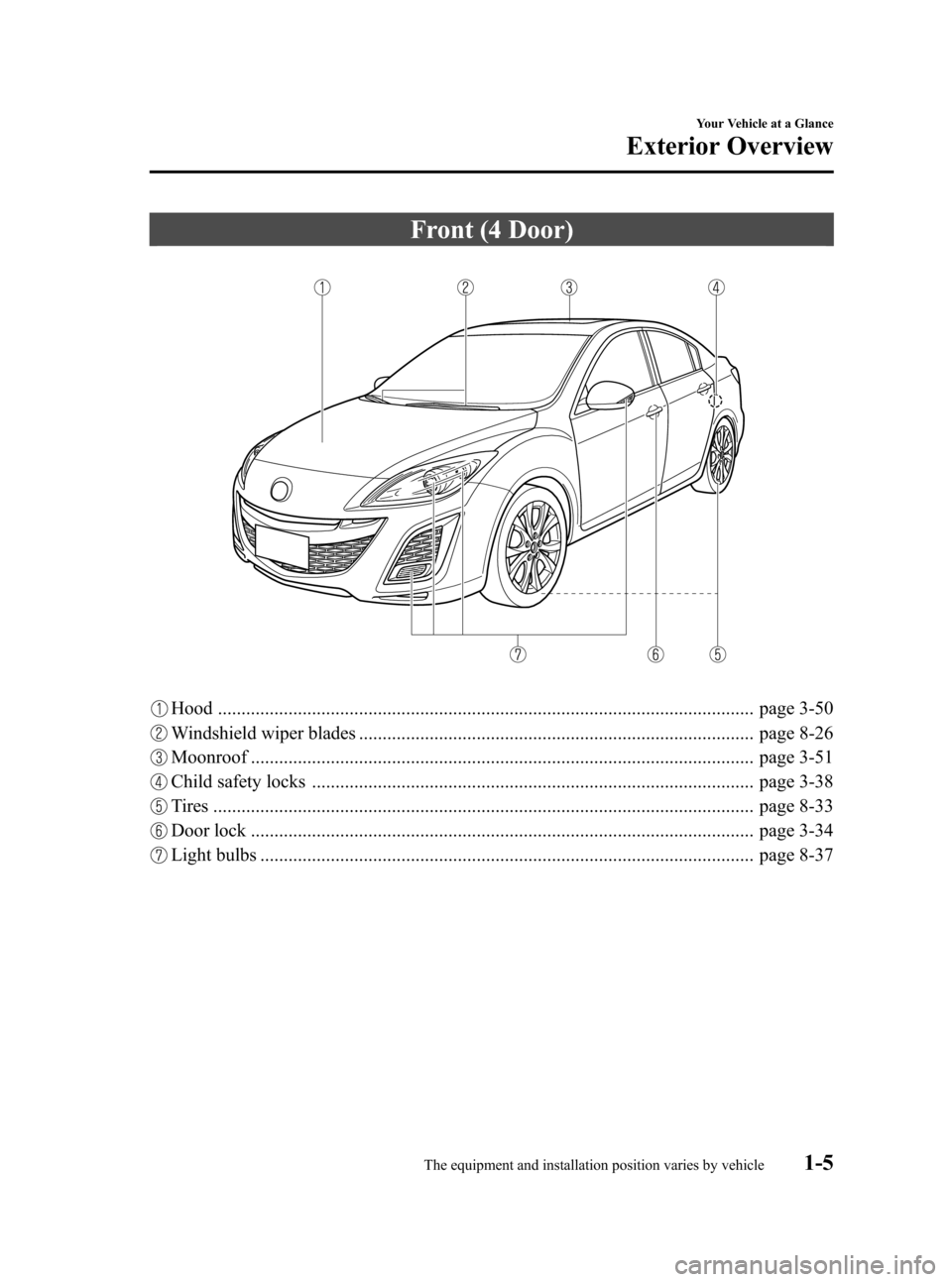
Black plate (11,1)
Front (4 Door)
Hood .................................................................................................................. page 3-50
Windshield wiper blades .................................................................................... page 8-26
Moonroof ........................................................................................................... page 3-51
Child safety locks .............................................................................................. page 3-38
Tires ................................................................................................................... page 8-33
Door lock ........................................................................................................... page 3-34
Light bulbs ......................................................................................................... page 8-37
Your Vehicle at a Glance
Exterior Overview
1-5The equipment and installation position varies by vehicle Mazda3_8AD6-EC-09A_Edition1 Page11
Tuesday, December 2 2008 2:26 PM
Form No.8AD6-EC-09A
Page 12 of 488
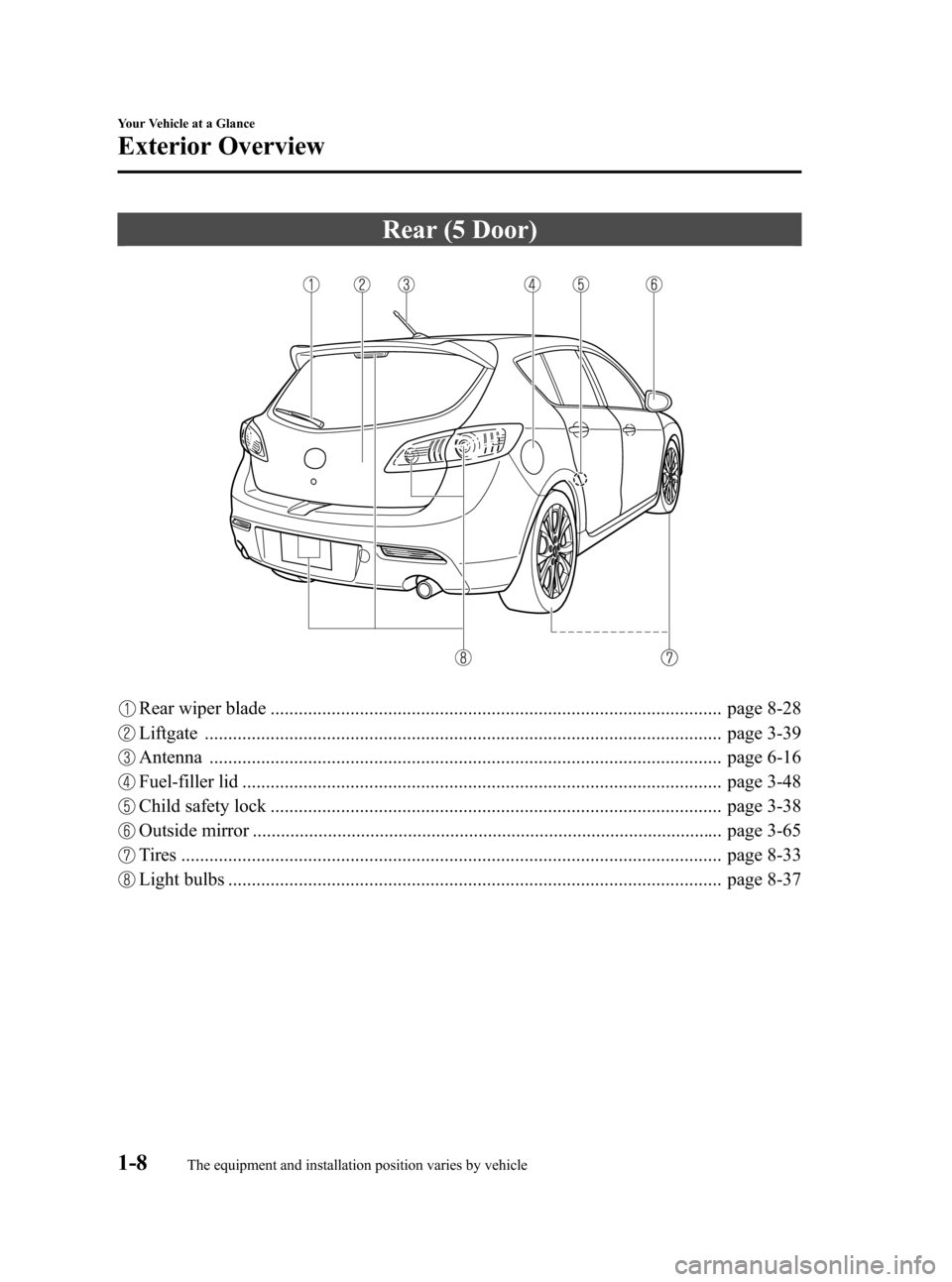
Black plate (14,1)
Rear (5 Door)
Rear wiper blade ................................................................................................ page 8-28
Liftgate .............................................................................................................. page 3-39
Antenna ............................................................................................................. page 6-16
Fuel-filler lid ...................................................................................................... page 3-48
Child safety lock ................................................................................................ page 3-38
Outside mirror .................................................................................................... page 3-65
Tires ................................................................................................................... page 8-33
Light bulbs ......................................................................................................... page 8-37
1-8
Your Vehicle at a Glance
The equipment and installation position varies by vehicle
Exterior Overview
Mazda3_8AD6-EC-09A_Edition1 Page14
Tuesday, December 2 2008 2:26 PM
Form No.8AD6-EC-09A
Page 22 of 488
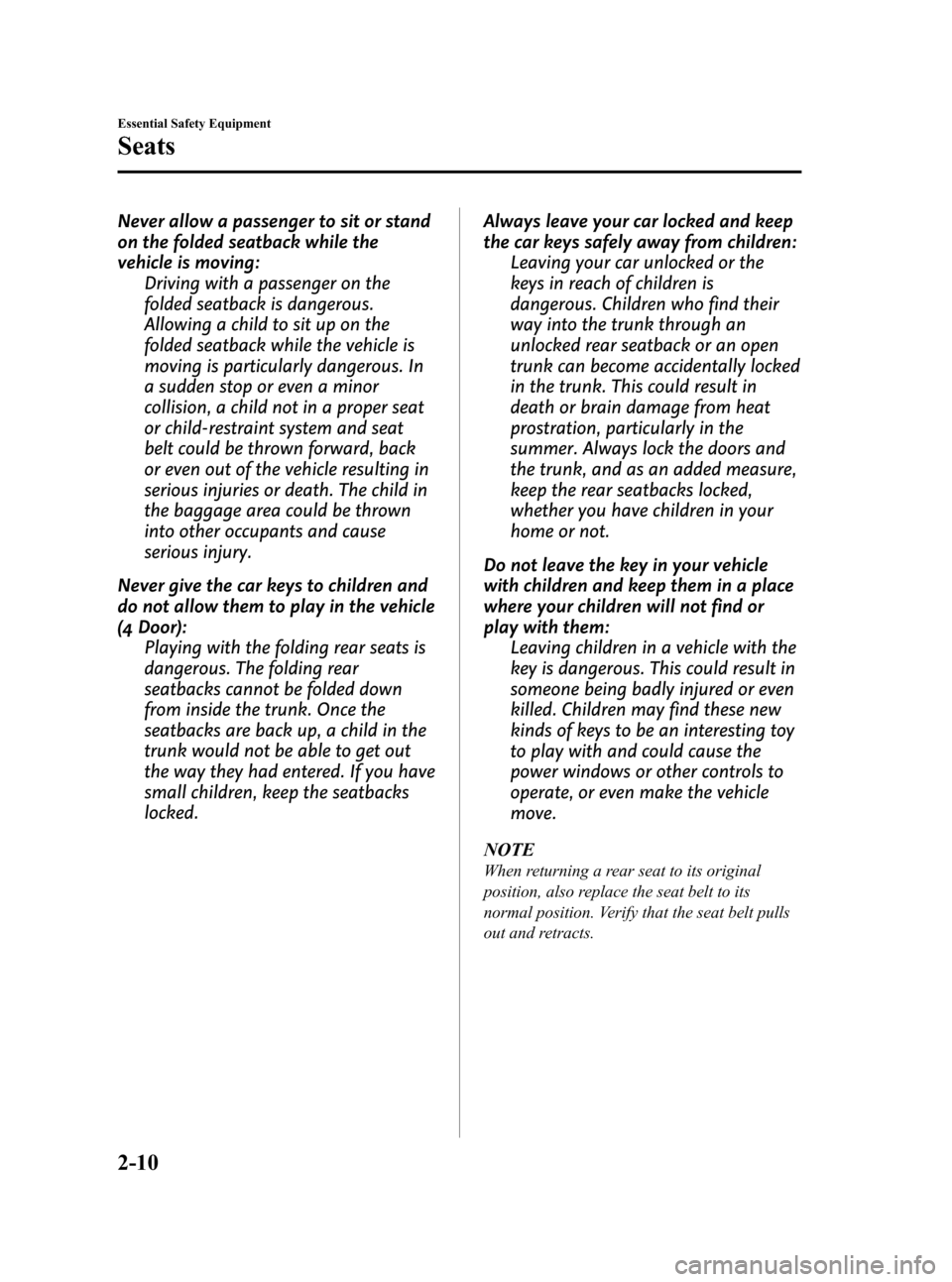
Black plate (24,1)
Never allow a passenger to sit or stand
on the folded seatback while the
vehicle is moving:
Driving with a passenger on the
folded seatback is dangerous.
Allowing a child to sit up on the
folded seatback while the vehicle is
moving is particularly dangerous. In
a sudden stop or even a minor
collision, a child not in a proper seat
or child-restraint system and seat
belt could be thrown forward, back
or even out of the vehicle resulting in
serious injuries or death. The child in
the baggage area could be thrown
into other occupants and cause
serious injury.
Never give the car keys to children and
do not allow them to play in the vehicle
(4 Door):
Playing with the folding rear seats is
dangerous. The folding rear
seatbacks cannot be folded down
from inside the trunk. Once the
seatbacks are back up, a child in the
trunk would not be able to get out
the way they had entered. If you have
small children, keep the seatbacks
locked.Always leave your car locked and keep
the car keys safely away from children:
Leaving your car unlocked or the
keys in reach of children is
dangerous. Children who find their
way into the trunk through an
unlocked rear seatback or an open
trunk can become accidentally locked
in the trunk. This could result in
death or brain damage from heat
prostration, particularly in the
summer. Always lock the doors and
the trunk, and as an added measure,
keep the rear seatbacks locked,
whether you have children in your
home or not.
Do not leave the key in your vehicle
with children and keep them in a place
where your children will not find or
play with them:
Leaving children in a vehicle with the
key is dangerous. This could result in
someone being badly injured or even
killed. Children may find these new
kinds of keys to be an interesting toy
to play with and could cause the
power windows or other controls to
operate, or even make the vehicle
move.
NOTE
When returning a rear seat to its original
position, also replace the seat belt to its
normal position. Verify that the seat belt pulls
out and retracts.
2-10
Essential Safety Equipment
Seats
Mazda3_8AD6-EC-09A_Edition1 Page24
Tuesday, December 2 2008 2:26 PM
Form No.8AD6-EC-09A
Page 28 of 488
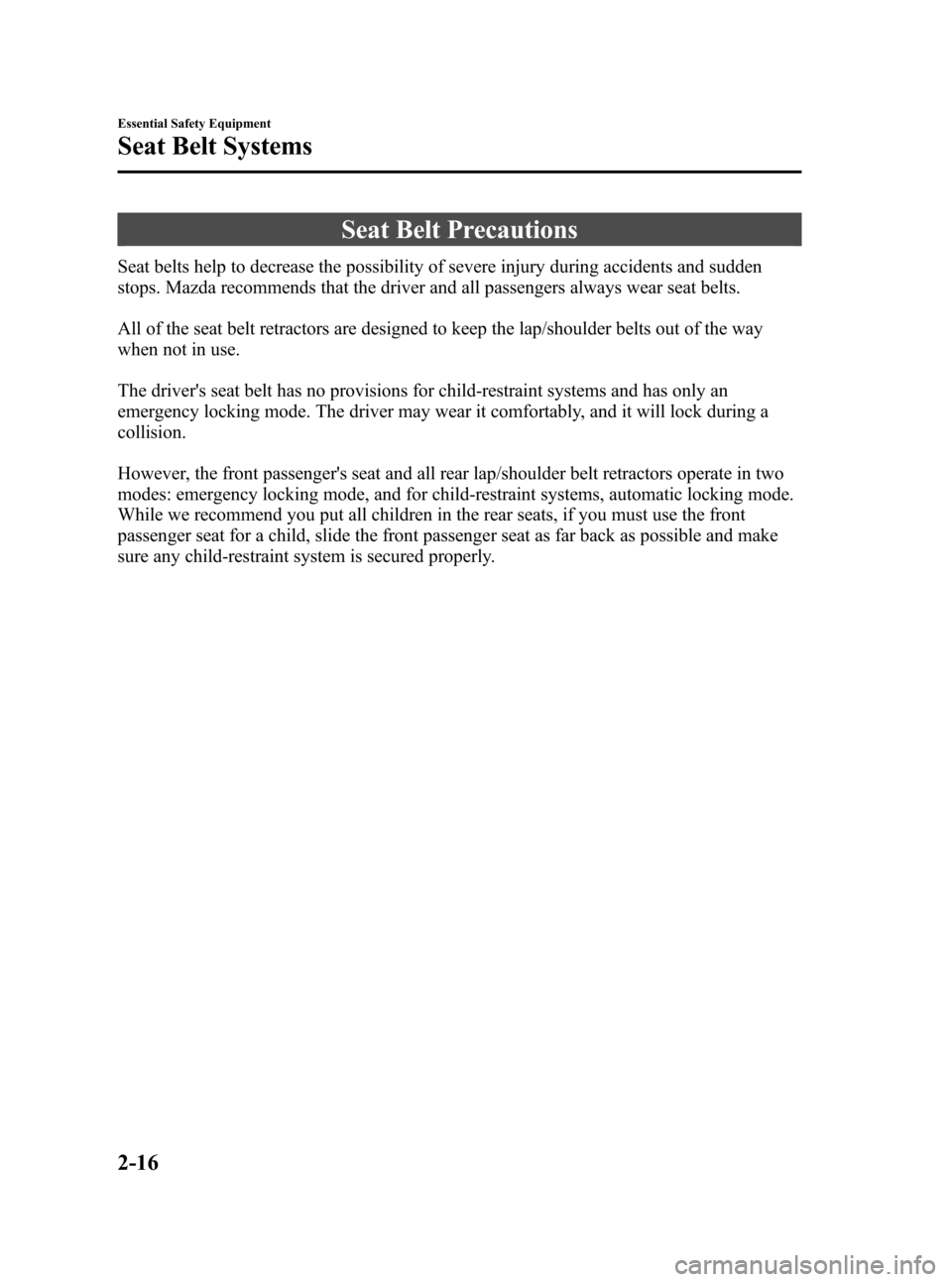
Black plate (30,1)
Seat Belt Precautions
Seat belts help to decrease the possibility of severe injury during accidents and sudden
stops. Mazda recommends that the driver and all passengers always wear seat belts.
All of the seat belt retractors are designed to keep the lap/shoulder belts out of the way
when not in use.
The driver's seat belt has no provisions for child-restraint systems and has only an
emergency locking mode. The driver may wear it comfortably, and it will lock during a
collision.
However, the front passenger's seat and all rear lap/shoulder belt retractors operate in two
modes: emergency locking mode, and for child-restraint systems, automatic locking mode.
While we recommend you put all children in the rear seats, if you must use the front
passenger seat for a child, slide the front passenger seat as far back as possible and make
sure any child-restraint system is secured properly.
2-16
Essential Safety Equipment
Seat Belt Systems
Mazda3_8AD6-EC-09A_Edition1 Page30
Tuesday, December 2 2008 2:26 PM
Form No.8AD6-EC-09A
Page 31 of 488

Black plate (33,1)
qAutomatic Locking Mode
Always use the automatic locking mode to keep the child-restraint system from shifting to
an unsafe position in the event of an accident. To enable seat belt automatic locking mode,
pull it all the way out and connect it as instructed on the child-restraint system. It will
retract down to the child-restraint system and stay locked on it. See the section on child
restraint (page 2-28).
Essential Safety Equipment
Seat Belt Systems
2-19
Mazda3_8AD6-EC-09A_Edition1 Page33
Tuesday, December 2 2008 2:26 PM
Form No.8AD6-EC-09A
Page 43 of 488
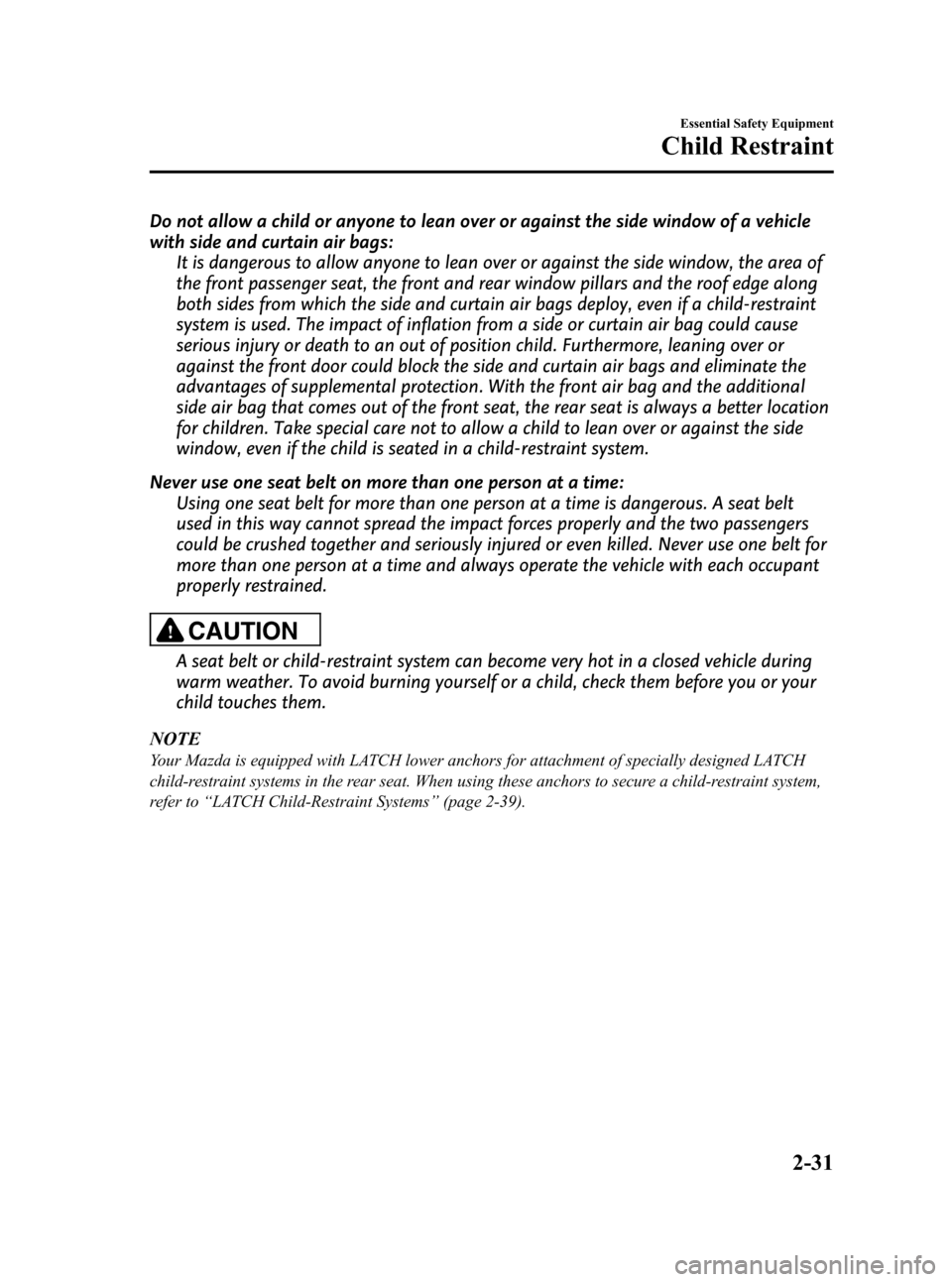
Black plate (45,1)
Do not allow a child or anyone to lean over or against the side window of a vehicle
with side and curtain air bags:
It is dangerous to allow anyone to lean over or against the side window, the area of
the front passenger seat, the front and rear window pillars and the roof edge along
both sides from which the side and curtain air bags deploy, even if a child-restraint
system is used. The impact of inflation from a side or curtain air bag could cause
serious injury or death to an out of position child. Furthermore, leaning over or
against the front door could block the side and curtain air bags and eliminate the
advantages of supplemental protection. With the front air bag and the additional
side air bag that comes out of the front seat, the rear seat is always a better location
for children. Take special care not to allow a child to lean over or against the side
window, even if the child is seated in a child-restraint system.
Never use one seat belt on more than one person at a time:
Using one seat belt for more than one person at a time is dangerous. A seat belt
used in this way cannot spread the impact forces properly and the two passengers
could be crushed together and seriously injured or even killed. Never use one belt for
more than one person at a time and always operate the vehicle with each occupant
properly restrained.
CAUTION
A seat belt or child-restraint system can become very hot in a closed vehicle during
warm weather. To avoid burning yourself or a child, check them before you or your
child touches them.
NOTE
Your Mazda is equipped with LATCH lower anchors for attachment of specially designed LATCH
child-restraint systems in the rear seat. When using these anchors to secure a child-restraint system,
refer to“LATCH Child-Restraint Systems”(page 2-39).
Essential Safety Equipment
Child Restraint
2-31
Mazda3_8AD6-EC-09A_Edition1 Page45
Tuesday, December 2 2008 2:26 PM
Form No.8AD6-EC-09A
Page 44 of 488
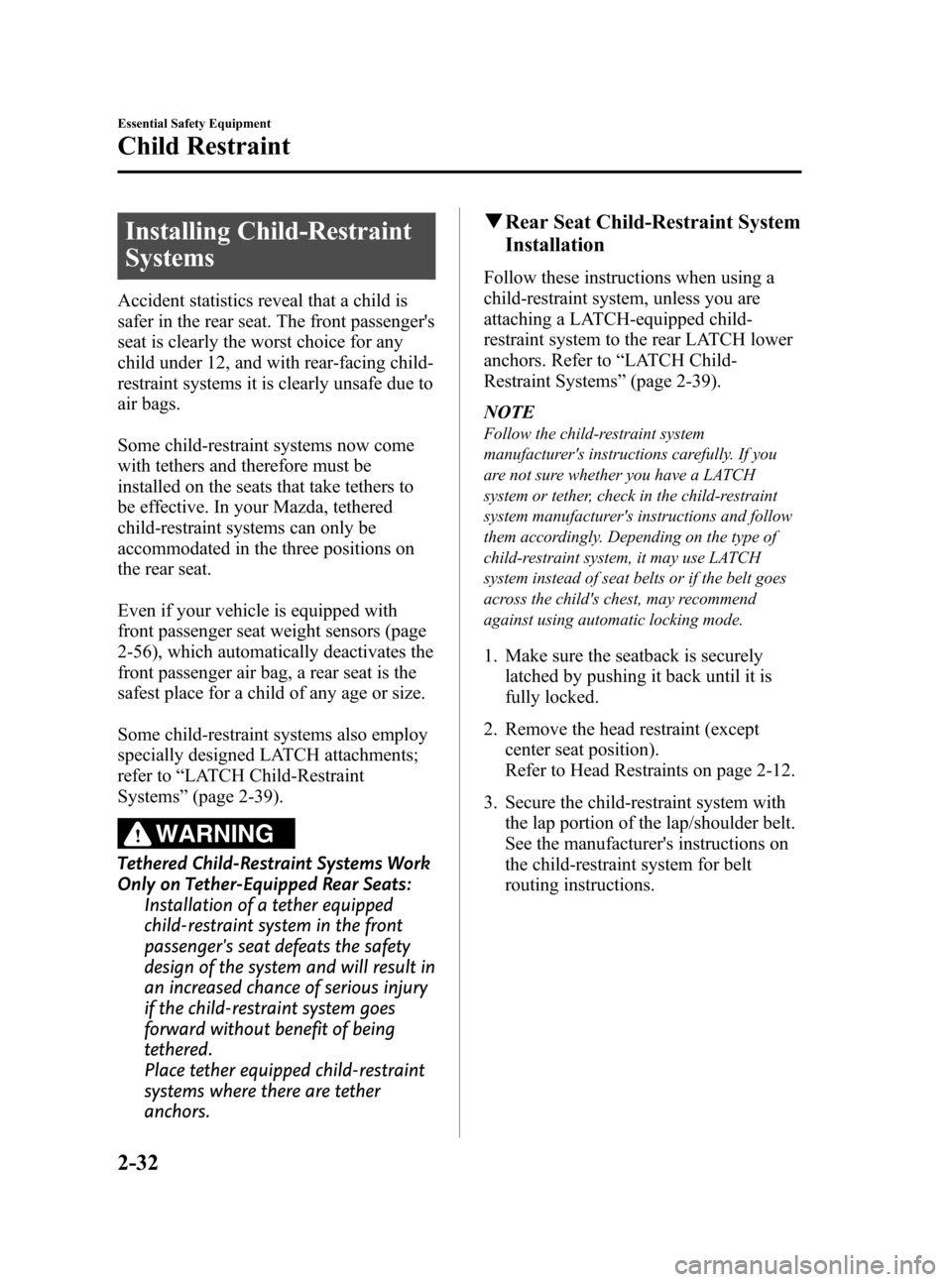
Black plate (46,1)
Installing Child-Restraint
Systems
Accident statistics reveal that a child is
safer in the rear seat. The front passenger's
seat is clearly the worst choice for any
child under 12, and with rear-facing child-
restraint systems it is clearly unsafe due to
air bags.
Some child-restraint systems now come
with tethers and therefore must be
installed on the seats that take tethers to
be effective. In your Mazda, tethered
child-restraint systems can only be
accommodated in the three positions on
the rear seat.
Even if your vehicle is equipped with
front passenger seat weight sensors (page
2-56), which automatically deactivates the
front passenger air bag, a rear seat is the
safest place for a child of any age or size.
Some child-restraint systems also employ
specially designed LATCH attachments;
refer to“LATCH Child-Restraint
Systems”(page 2-39).
WARNING
Tethered Child-Restraint Systems Work
Only on Tether-Equipped Rear Seats:
Installation of a tether equipped
child-restraint system in the front
passenger's seat defeats the safety
design of the system and will result in
an increased chance of serious injury
if the child-restraint system goes
forward without benefit of being
tethered.
Place tether equipped child-restraint
systems where there are tether
anchors.
qRear Seat Child-Restraint System
Installation
Follow these instructions when using a
child-restraint system, unless you are
attaching a LATCH-equipped child-
restraint system to the rear LATCH lower
anchors. Refer to“LATCH Child-
Restraint Systems”(page 2-39).
NOTE
Follow the child-restraint system
manufacturer's instructions carefully. If you
are not sure whether you have a LATCH
system or tether, check in the child-restraint
system manufacturer's instructions and follow
them accordingly. Depending on the type of
child-restraint system, it may use LATCH
system instead of seat belts or if the belt goes
across the child's chest, may recommend
against using automatic locking mode.
1. Make sure the seatback is securely
latched by pushing it back until it is
fully locked.
2. Remove the head restraint (except
center seat position).
Refer to Head Restraints on page 2-12.
3. Secure the child-restraint system with
the lap portion of the lap/shoulder belt.
See the manufacturer's instructions on
the child-restraint system for belt
routing instructions.
2-32
Essential Safety Equipment
Child Restraint
Mazda3_8AD6-EC-09A_Edition1 Page46
Tuesday, December 2 2008 2:26 PM
Form No.8AD6-EC-09A
Page 45 of 488
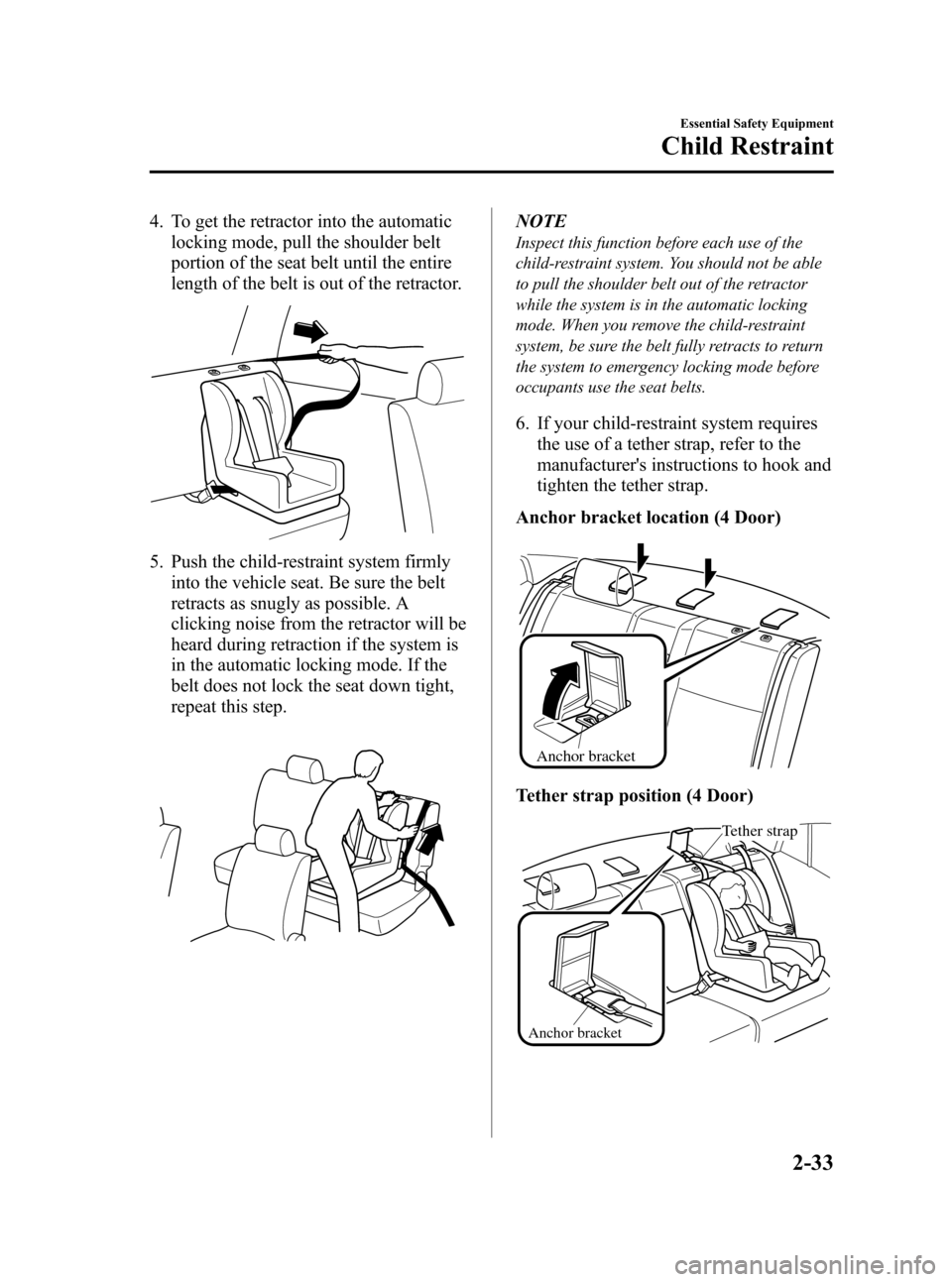
Black plate (47,1)
4. To get the retractor into the automatic
locking mode, pull the shoulder belt
portion of the seat belt until the entire
length of the belt is out of the retractor.
5. Push the child-restraint system firmly
into the vehicle seat. Be sure the belt
retracts as snugly as possible. A
clicking noise from the retractor will be
heard during retraction if the system is
in the automatic locking mode. If the
belt does not lock the seat down tight,
repeat this step.
NOTE
Inspect this function before each use of the
child-restraint system. You should not be able
to pull the shoulder belt out of the retractor
while the system is in the automatic locking
mode. When you remove the child-restraint
system, be sure the belt fully retracts to return
the system to emergency locking mode before
occupants use the seat belts.
6. If your child-restraint system requires
the use of a tether strap, refer to the
manufacturer's instructions to hook and
tighten the tether strap.
Anchor bracket location (4 Door)
Anchor bracket
Tether strap position (4 Door)
Anchor bracket
Tether strap
Essential Safety Equipment
Child Restraint
2-33
Mazda3_8AD6-EC-09A_Edition1 Page47
Tuesday, December 2 2008 2:26 PM
Form No.8AD6-EC-09A
Page 48 of 488
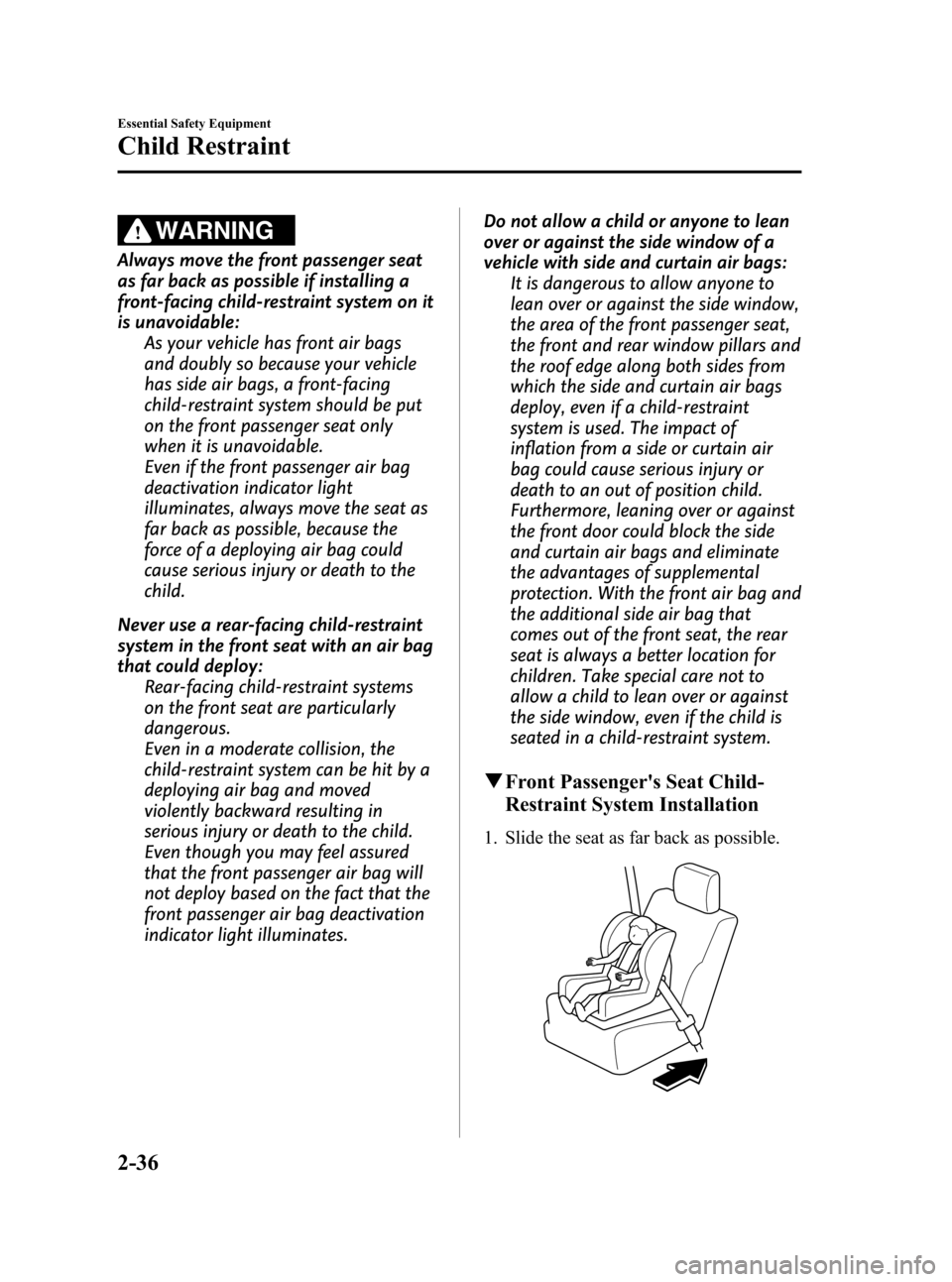
Black plate (50,1)
WARNING
Always move the front passenger seat
as far back as possible if installing a
front-facing child-restraint system on it
is unavoidable:
As your vehicle has front air bags
and doubly so because your vehicle
has side air bags, a front-facing
child-restraint system should be put
on the front passenger seat only
when it is unavoidable.
Even if the front passenger air bag
deactivation indicator light
illuminates, always move the seat as
far back as possible, because the
force of a deploying air bag could
cause serious injury or death to the
child.
Never use a rear-facing child-restraint
system in the front seat with an air bag
that could deploy:
Rear-facing child-restraint systems
on the front seat are particularly
dangerous.
Even in a moderate collision, the
child-restraint system can be hit by a
deploying air bag and moved
violently backward resulting in
serious injury or death to the child.
Even though you may feel assured
that the front passenger air bag will
not deploy based on the fact that the
front passenger air bag deactivation
indicator light illuminates.Do not allow a child or anyone to lean
over or against the side window of a
vehicle with side and curtain air bags:
It is dangerous to allow anyone to
lean over or against the side window,
the area of the front passenger seat,
the front and rear window pillars and
the roof edge along both sides from
which the side and curtain air bags
deploy, even if a child-restraint
system is used. The impact of
inflation from a side or curtain air
bag could cause serious injury or
death to an out of position child.
Furthermore, leaning over or against
the front door could block the side
and curtain air bags and eliminate
the advantages of supplemental
protection. With the front air bag and
the additional side air bag that
comes out of the front seat, the rear
seat is always a better location for
children. Take special care not to
allow a child to lean over or against
the side window, even if the child is
seated in a child-restraint system.
qFront Passenger's Seat Child-
Restraint System Installation
1. Slide the seat as far back as possible.
2-36
Essential Safety Equipment
Child Restraint
Mazda3_8AD6-EC-09A_Edition1 Page50
Tuesday, December 2 2008 2:26 PM
Form No.8AD6-EC-09A
Page 49 of 488
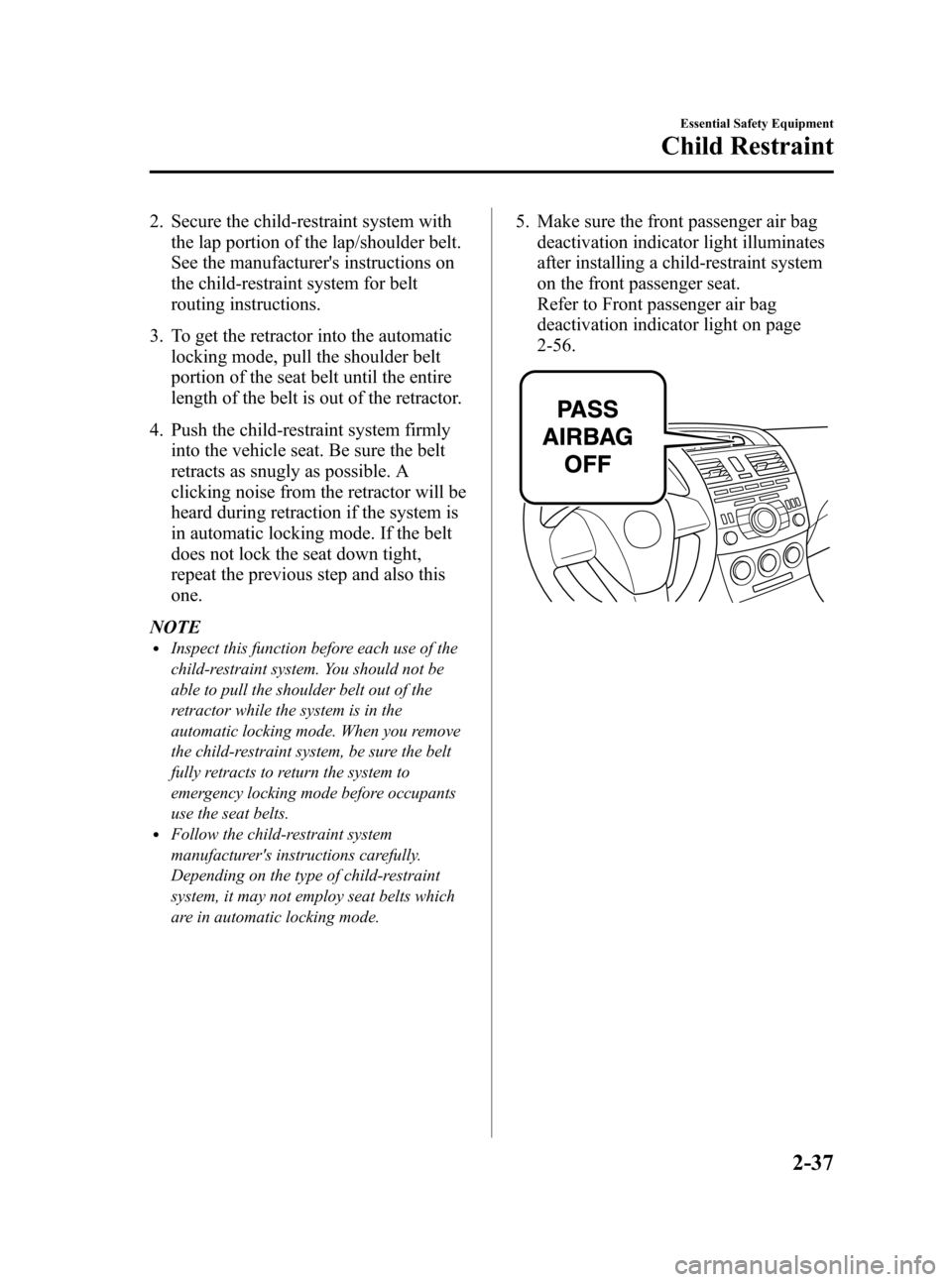
Black plate (51,1)
2. Secure the child-restraint system with
the lap portion of the lap/shoulder belt.
See the manufacturer's instructions on
the child-restraint system for belt
routing instructions.
3. To get the retractor into the automatic
locking mode, pull the shoulder belt
portion of the seat belt until the entire
length of the belt is out of the retractor.
4. Push the child-restraint system firmly
into the vehicle seat. Be sure the belt
retracts as snugly as possible. A
clicking noise from the retractor will be
heard during retraction if the system is
in automatic locking mode. If the belt
does not lock the seat down tight,
repeat the previous step and also this
one.
NOTE
lInspect this function before each use of the
child-restraint system. You should not be
able to pull the shoulder belt out of the
retractor while the system is in the
automatic locking mode. When you remove
the child-restraint system, be sure the belt
fully retracts to return the system to
emergency locking mode before occupants
use the seat belts.
lFollow the child-restraint system
manufacturer's instructions carefully.
Depending on the type of child-restraint
system, it may not employ seat belts which
are in automatic locking mode.
5. Make sure the front passenger air bag
deactivation indicator light illuminates
after installing a child-restraint system
on the front passenger seat.
Refer to Front passenger air bag
deactivation indicator light on page
2-56.
Essential Safety Equipment
Child Restraint
2-37
Mazda3_8AD6-EC-09A_Edition1 Page51
Tuesday, December 2 2008 2:26 PM
Form No.8AD6-EC-09A